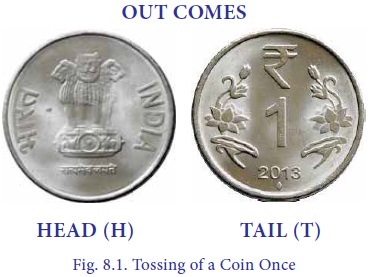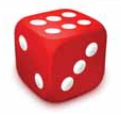Chapter: 11th Statistics : Chapter 8 : Elementary Probability Theory
Random experiment, Sample space, Sample point
Random
experiment, Sample space, Sample point
Experiment: In Statistics, by the
word experiment it means ŌĆśan attempt to produce a resultŌĆÖ. It need not be a laboratory experiment.
Random Experiment: If an experiment is such that
(i) all the possible outcomes of the experiment are predictable,
in advance
(ii) outcome of any trial of the experiment is not known, in
advance, and
(iii) it can be repeated any number of times under identical
conditions, is called a random experiment.
Sample space: The set of all
possible outcomes of a random experiment is called the sample space of the experiment and is usually denoted by S (or
╬®). If S contains only
finite number of elements, it
is termed as finite sample space. If S contains countable number of elements, S
may be called as countable sample space or discrete sample space. Otherwise, S
is called an uncountable sample space.
Sample Point: The outcome of a
random experiment is called a sample point, which is an element in S.
Example 8.1
Consider the random experiment of tossing a coin once ŌĆ£HeadŌĆØ and
ŌĆ£TailŌĆØ are the two possible outcomes. The sample space is S = {H, T}. It is a
finite sample space which is presented in fig. 8.1.

Example 8.2
Suppose that a study is conducted on all families with one or
two children. The possible outcomes, in the order of births, are: boy only,
girl only, boy and girl, girl and boy, both are boys and both are girls. Then,
the sample space is S = {b,g,bg,gb,bb,gg}. It is also a finite sample space.
Here, ŌĆśbŌĆÖ represents the child is a boy and ŌĆśgŌĆÖ represents the child is a girl.
Example 8.3
Consider the experiment of tossing a coin until head appears.
Then, the sample space of this experiment is S = { (H), (T,H), (T,T,H),
(T,T,T,H), ŌĆ” }. This is a countable sample space. If head appears in the first
trial itself, then the element of S is (H); if head appears in the second
attempt then the element of S is (T,H); if head appears in the third attempt
then the element of S is (T,T,H) and so on.
Example 8.4
In the experiment of observing the lifetime of any animate or
inanimate things, the sample space is
S = {x: xŌēź0},
where x denotes the
lifetime. It is an example for uncountable sample space.
Event: A subset of the sample
space is called an event. In this chapter,
events are denoted by upper case English alphabets and the elements of the
subsets by lower case English alphabets.
In Example 8.2, the event that the eldest child in the families
is a girl is represented as
A = {g, gb, gg}
The event that the families have one boy is represented as
B = {b, bg}.
In Example 8.4, A
refers to the event that the refrigerator works to a maximum of 5000 hours.
Then A = { x: 0 < x Ōēż 5000 } is the subset of
Mutually exclusive events
Two or more events are said to be mutually exclusive, when the
occurrence of any one event excludes the occurrence of other event. Mutually
exclusive events cannot occur simultaneously.
In particular, events A and B are said to be mutually exclusive
if they are disjoint, that is, A Ōł® B = ├ś
Consider the case of rolling a die. Let A = {1, 2, 3} and B =
{4, 5, 6} be two events. Then we find A
Ōł® B = ├ś . Hence A and B are said to be mutually exclusive
events.

Related Topics